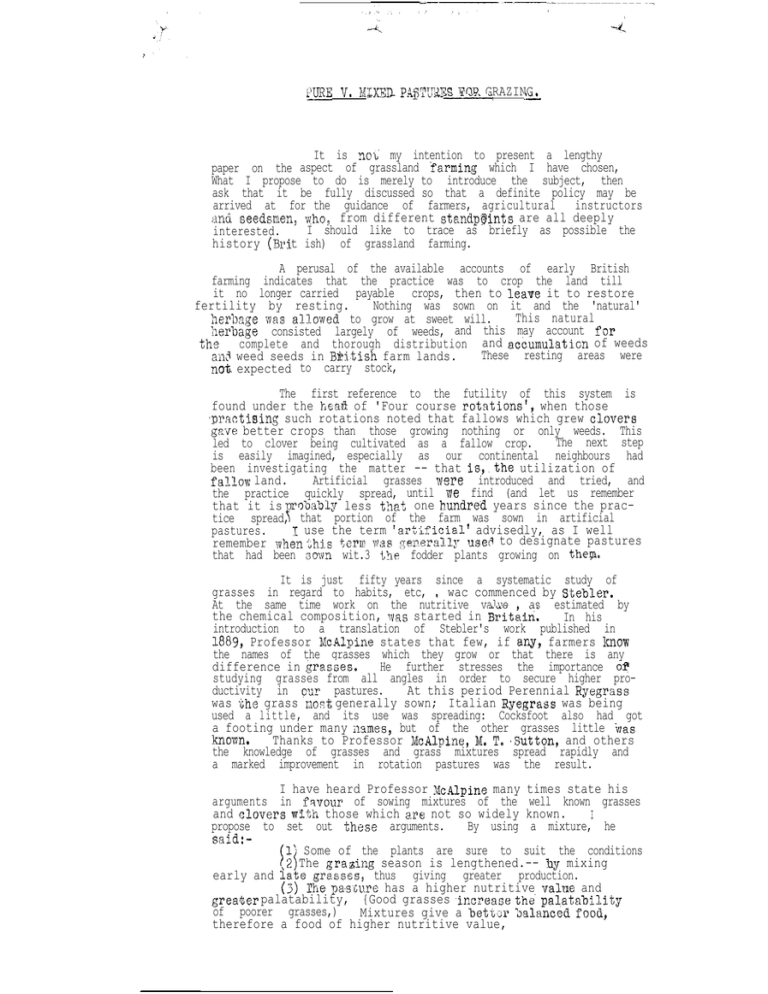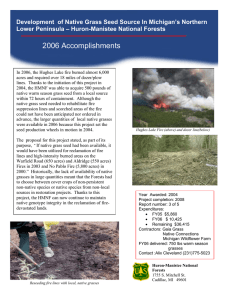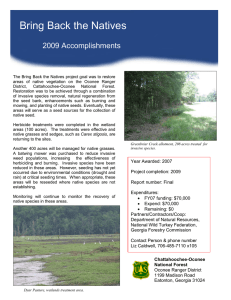(TJRE v. MIXED P, I’
advertisement

(TJRE v. MIXED
3'09 GRAZING
."A
- - P,4?TX;IES
II’ - -4.
It is no.; my intention to present a lengthy
which I have chosen,
paper on the aspect of grassland rarming
What I propose to do is merely to introduce the subject, then
ask that it be fully discussed so that a definite policy may be
arrived at for the guidance of farmers, agricultural
instructors
md seedsmen? vfho, from different standppints are all deeply
I should like to trace as briefly as possible the
interested.
history (W~>i t ish) of grassland farming.
A perusal of the available accounts of early British
farming indicates that the practice was to crop the land till
it no longer carried payable crops, then to leave it to restore
fertility by resting.
Nothing was sown on it and the 'natural'
This natural
herbage was allomed to grow at sweet will.
and
this
may account for
herbage
consisted largely of weeds,
and
accumulaticn
of weeds
the
complete and thorough distribution
These
resting
areas
were
an3 weed seeds in Biitish farm lands.
to
carry
stock,
no% expected
The first reference to the futility of this system is
found under the head of 'Four course rotations'9 when those
'uractising such rotations noted that fallows which grew clovers
ia-\re better crops than those growing nothing or only weeds. This
The next step
led to clover being cultivated as a fallow crop.
is easily imagined, especially as our continental neighbours had
been investigating the matter -- that is,,the utilization of
falloff land.
Artificial grasses :vere introduced and tried, and
the practice quickly spread, until vie find (and let us remember
that it is robably less thaf, one hundre'd years since the practice spread,P that portion of the farm was sown in artificial
I use the term 'artificial' advisedly, as I well
pastures.
remember mhen -Ghis term ~fi/as ;ser.eral.ly used to designate pastures
that had been sown wit.3 the fodder plants growing on the!&
It is just fifty years since a systematic study of
grasses in regard to habits, etc, 9 wac commenced by Stebler.
At the same time work on the nutritive value
as estimated by
the chemical composition, was started in Britkin.
In his
introduction to a translation of Stebler's work published in
1809, Professor McAlpine states that few, if arg, farmers know
the names of the grasses which they grow or that there is any
difference in &asses*
He further stresses the importance 09
studying grasses from all angles in order to secure higher productivity in qr pastures.
At this period Perennial Ryegrass
was -bhe grass r.zos”t. generally sown; Italian Ryegrass was being
used a little, and its use was spreading: Cocksfoot also had got
a footing under many names9 but of the other grasses little tias
knolqn,
Thanks to Professor &Alpine, M. T. ,Sutton, and others
the knowledge of grasses and grass mixtures spread rapidly and
a marked improvement in rotation pastures was the result.
I have heard Professor McAlpine many times state his
arguments in favour of sowing mixtures of the well known grasses
and c:lovers w'Lth. those which a-re not so widely known.
I
propose to set out these arguments.
By using a mixture, he
said:1: Some of the plants are sure to suit the conditions
,%
1 I The gra%ing season is lengthened.-- hy mixing
early and :$e_grasses, thus giving greater production.
Lhe pasbure has a higher nutritive valrne and
grea.ter palatability, {Good grasses ,increase th& pal.atability
of poorer grasses,)
Mixtures give a beti;:>r Salanced food)
therefore a food of higher nutritive value,
-
--
.---.- ---- - -.
(ic) A bettm sole is obtained,
Top and bottom
qrasc-es occupy -the surface better than any single grass.
(5) Better occu:Gation of the soil is obtained by deep)
and shallow rooted grasses, which further pave the way for one
another a
(6) T”ne pasturas l a s t o u t bettei- i f t h e m i x t u r e i s
properly proportioned, as the more permanent grasses fill the
g:aps left. by temporary types.
(7) P‘~Op~~l;;r pj?Opo.T tioned mixtures reduce the weeds on
the farm by leaving no gaps on which weeds may grow,
These arguments hold good to-day, with the exception
of the hit and miss. recommenda-Lion
in regard to some being sure
‘(Jr i t, >A our better knowledge we can ’
to suit the conditions,
se?-ect suitable grasses? as has been done for many years.
1-t is no*$$ possible to trac.e how the unsatisfactory
development in regard. to pastures end pasture plant's has been
br ou,gh t ab out *
Farmers, like others, are fa.&cin&ed by quick
returns*
The rapid gPOWth Of temporary types Of grasses and
clovers led to th.%ir indiscriminate :?.se -- a happening which I
have heard McAlpine predict and warm his Bearers against.
It
is diffic~~lt, however, as we have all found, to control any
practice which has become popular,
This prsctise combined with
o t h e r factors finslised our d i f f i c u l t i e s .
The demand for grass
and z.luver seed led to a new brslnch of farming -- saving of
g::s.ss seed and clover seed.
The seed grower as such is o%~!~’
with one thing, the production of seed, the greater the yield of
seed t,hi: grea-tey the cash returnsNaturally the growers
selected. or obtained- high seed producing strains, not knowgng
that there was any difference from the pasture point of view,
Seedsmen, also bought an d sold what, they got i”n ignorance of
their true value.
The ;,~~actice of growing for seed did not in
itself lead to disaster so long as pure stands were sown, but it
was becallse mix$ures were sowz and harvested that detcrioraticn
ha.s been so rapid in the last forty vears*
i?rior t o t h i s :
mixtures were not usec’*.Farmers soon appreciated the value of
a. mixed pasture for grazing purposes., 3ut TAnfortunately followed
the old practri.ce of saving the first year’s growth, or a portion
o f i t , for seed, with the result which we nw know.
Not o n l y
did ae get sttammy types as Sefore, but hybridization took place
rind so quickly ::~~aolvecl. Rl?.d developed a mongrel and degenerate
race.
I often feel myself that L may have assisted in bringing one well known seed growjr;g area in Ireland into disrepute
by .advising th?$y odd years ago the use of mixtures for grazing
purposes, a n d f a i l i n g t o emphasise the fact that these mixtures
could not be saved for seed; and that seed pastures most be
s ecially treated,
I may have been the’ unconscious agent in
hii ‘lping to bring about the downfall of this district as a seed
growing area? but I da kn.ow further that the extra yields from.
the mixed sowings were the biggest factors.
In many cases the
growers deliberately mixed-the seed once they discovered &he
possibilities in yield,
There was another blunder made by these British
Pioneers which we in 1u’ew Zealand would do well to avoid and that
was .t.he compiling and recommending of a standard mixture for
use on every class of soil and under every condition, Naturally
many unsatisfactory :?esults followed and confidence in pasture
mixtures was shaken, but so far as the BFitisb farmer is concerned the pasture-=
problem h’ls been more or less solved.
One
thing that does strike a visXtor to that country is the excellence of the pastures on the better farmed areas.
WE&. condftiona
were largely rcsponsS.b~ie
f cr t h e improvemcnto
When stock were
a-L famine prices and labour scarce the farmer concentrated on
stock raising and pasture improvement, ~!iLh the result tI;at he
?..
now knows which grasses and clovers grow best on his land, and
the best proportions of each. to sow in a mixture,
Up t 0 no6 I have deal-t wli.th the evolution of the mixed
pasture in Britain,
It i s sai6. th.at history repeats jtself,
and anyone night imagine I had dealt with the. evolution of the
New Zealand pastu.ne, up to a point. -- that is, the improvement.
My experience of New Zealand pasture soyiing dates back
twenty four years.
The practice up to -that time was generally
to soi,v down exhauE.ted wheat lazd with
/
perennial ryegrass,
although in many cases the area was simply left to grow whatever
The rat.:e o:C seeding ani: the q-llality of the seed were
came u,bQ
not always as good as they should be, but with the Change over
from wheat growing., and the advance of the fat lamb trade more
interes’i; was taken in pc.stu.rs sowingS>
At my first, acquaintance
with New Zealand farming? te:aporary‘grasses and temporary types
were the rage,
Pastures to last three, fcur, and five years
were sown either with :l-~:Salian,
o r a f i f t y - f i f t y ini.xture o f
Italian and l?ere;mia:l+,
The practice, I regret to say, arose
largely through the ~~isinterpretation of a report on the carrying
capacity of Italiad ryegrass In yL-ts; first year issued by my
predecessor.
The
The effect on our pastures was disastrous,
poor carrying capacity in th?.e second, third, and fourth year
was disregarded;
seed was saved from pure temporary Q-pes and
mi;-ed hypes, and this seed was sold and distributed as ryegrass.
The farmers may have been primarily responsible, but I feel
compelled to add that seedsmen and seed-dealers assisted in the
debacle.
I t i s s a i d t h a t i? i s easy to start a runour but hard
to ‘Scotch’ it.
We find it just as difficult to stem a
practice which has any glamour about it, and we certainly found
that the farmer VJJC?B ha~.rC to convince that t,emporary
grasses
could not be used for pastures retained for more than one year,
At the.College in LcjLl and 15l2 areas were sown with vario;ls
mixtures to demonstrate the l;oint.
In fact the 1912 sowing is
s t i l l i n existence0
The c;onplet& o r almost complete disappearance of temporary grasses in ),he second year and our published
statement did help to convince many into recasting their
practice.
Unfortunately the world war intervened and it had just
tiehe reverse effect on our pasture lands in New Zealand f’r.om what
it had in Britain.
New Zealand was dependant on her own
resources for grass-seed a:2d, in consequence the price of seed
soared to famine level - an;c thing sold,
Temporary grasses are
high seed producers and pFaT~o
::,
the best y?elds, and were, of
course, grown.
The seed 1”’
-,:’s saved, sold and distributed with
There were attempts at sowing
the result now so well E.&own,
Cocksf oat
mixtures, but even .tCen seeding types were used,
went to a high price,. -A :.~3our was scarce, it was grown and
GI the plains where heavy seeding
harvested with a bin&e:?.
type gave the best, returns7 thus Cocksfoot came into disrepute.
In order to obtain $eLter and more permanent types,
farmers were advised. to cut seed from old pastures9 but litt,le
notice was taken of this advice,
There are several reasons
which may be offered for t h i s :?,l?n..-obaer~~?ance.
Fat lambs were
selling at high rates; the old pastures carried more than the
new swardss e s p e c i a l l y i n SUN2ilrJ
the yield of seed from old
pastures is r e l a t i v e l y low a:,< is more d i f f i c u l t t o harvest9
and no extra price -YB.S offeredi :?or this old pasture seed. Thu t
i s , the seed gpoy;ep3 y+-c3. ses(:. ~;ritjp)ic~~~--ts ‘y:!~pe n0.t ali,Vks to ti19
v a l u e cf t h e see& ’
-4.-
\
At the College in 1920 it was decided to investigahe
grasses and a start was made in selecting types of CocksfOot.
Prog.ress was slow9 but we have succeeded in isolating a valuable
strain of Cocksfoot and wo hope we have secured also a permanent
Unfortunately this has taken
ssrain. of Perennial Ryegrass,
as
the
grower discovered his dilemma
almost twelve years9 and,
t ‘3 11 3’ 12 a .p R ago’ and raised an X,O.S Something had to be done then.
The
He WRS told to ILSU permanent instead of temporary types.
announcement by our authorities that a permanent type of ryegrasti was being harvested in one district in New Zealand. wa.s
taken ko imply that only thi s distridt produced permanent ryegra.ss.
Demonstrations of its rpermanancy in trial plots and
-bh(T; f&C% that these trial plots m e r e sown with one grass only
lc;:d
the belief popular to-day that pure souings are best. If
I. . stof’allncy
72121
iu not scotched we shall land in the same position
The pure
‘3 our British cousins nere in forty years ago,
&%ure craze fill. develop, and result in a reduced production,
2-s permanency does not necessarily secure higher yield,
especially if only one type of plant is growing.
I feel X am not overestimating the seriousness of
the position;
I look to a definite pronouncement from the
.3rassland Conference.
Farmers are Ioo,king’ for guidance.
Seedsmen and stock and station .agents who are sponsors to t.he
farmer. are also seeking enlightenment.
I would like to make
the following points clear to them,
(1) Permanent grasses do not necessariLy make good permanent.
pastures unless (a) They are of proven high producing
strains.
b Have a high feeding value.
i c 1 A r e d i s e a s e ,and drough-: r e s i s t a n t
(2)
Different strains may suit different areas, and confine
themselves to definite areas.
Any one strain or
group of strains cannot possible suit all t.ypes of
land,
(3) Poor pastures (1) will not increase production -- their
g r o w t h T,vill b e s e a s o n a i .
(11) Vi11 lack palatability and feeding
value
(111) Are more likely to be affected by
climatic
conditions.
(4)
Mixed past ures have all the advantages claimed for them
forty years ago by Professor Mcdlpine.
(5) Do not Judge pa’stures or pasture plants on their appearances
The worst pastures and plants often meetthe
eye best because no animal will eat them.
(6) Pasture establishment for grazing and seed production
should be clearly defined and treatment suitable to
obtaining best results from either prescribed.
Mr. J . W. Cal&r w i l l follow w i t h a discu?.sion
on grasses and mixtures suitable to the district wT,th
which he deals.
-----I-----....:-.,-.-:“.:-:: I - .- - - - - ^ - . .-. _- - - I.
.
.




